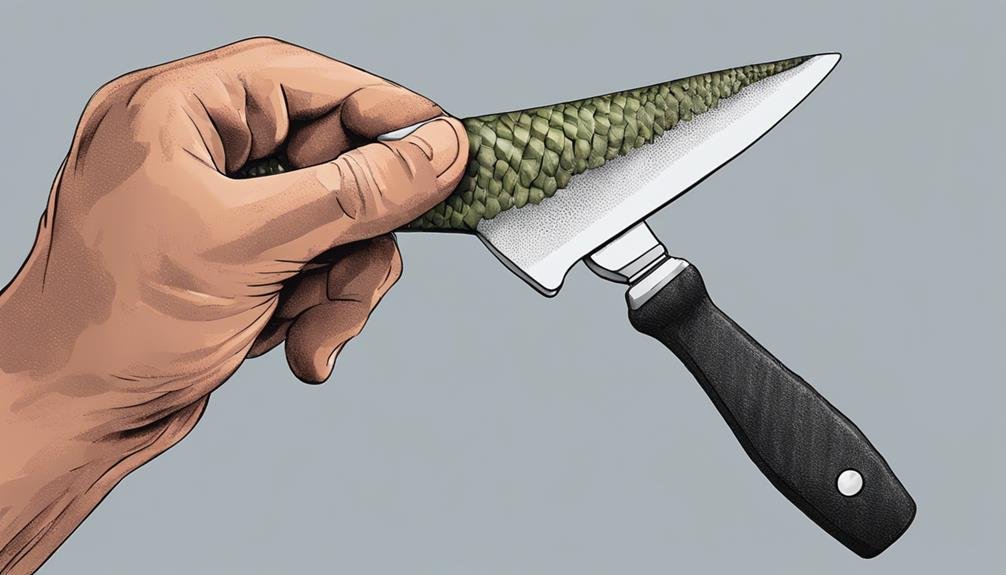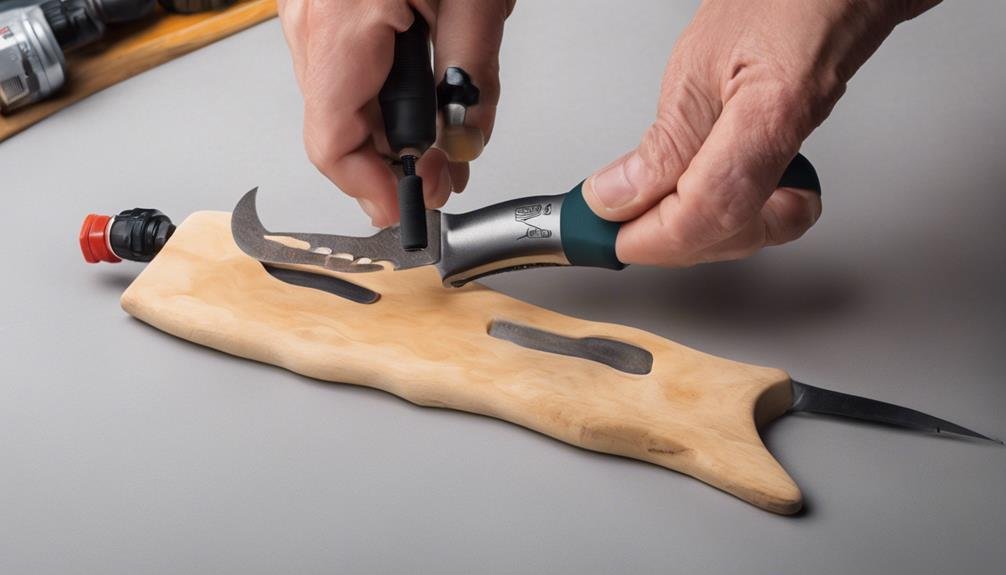When it comes to ensuring a secure grip on your fishing knife handle, there are key tips that can make a significant difference in your safety and performance while handling sharp tools near water. From selecting the right handle material to maintaining a firm grip technique, each tip plays an important role in enhancing your control and reducing the risk of accidents. By incorporating these strategies into your routine, you’ll be well-equipped to tackle any fishing task with confidence and precision, making your outdoor experiences more enjoyable and efficient.
Key Takeaways
- Opt for textured or rubberized handle for enhanced grip security in wet conditions.
- Keep hands clean and dry, avoiding lotions, oils, and using a towel.
- Use proper grip technique with secure finger positioning and firm pressure.
- Avoid excessive force, find a balance for a secure hold with non-slip materials.
- Check and tighten fastenings, ensure proper knife sheath fit, and focus on grip strength exercises.
Textured or Rubberized Handle
Opting for a textured or rubberized handle enhances grip security, essential for guaranteeing a non-slip experience when handling a fishing knife. The non-slip grip provided by these handles is a game-changer in challenging environments where wet conditions are prevalent. The textured surface of the handle plays a pivotal role in creating friction against your hand, granting you unparalleled control and stability during intricate cutting tasks.
Additionally, the ergonomic design of rubberized handles not only offers comfort but also ensures that the knife remains securely in your grasp, even when dealing with slippery fish or wet surfaces.
Thanks to their non-slip properties, textured or rubberized handles are the ideal choice for fishing enthusiasts. These handles mitigate the risk of accidents when working with sharp blades near water bodies, providing you with the confidence to focus on your task at hand. Whether you’re battling the elements on a stormy day or simply dealing with fish slime, a fishing knife equipped with a non-slip grip handle is your reliable companion in ensuring both safety and precision.
Clean and Dry Hands
To guarantee a secure grip when handling your fishing knife, always start by thoroughly cleaning and drying your hands before use. Moisture on your hands can lead to a slippery handle, compromising your grip and potentially causing accidents. Here are some practical tips to make sure your hands are in the best condition for a secure hold:
| Tips for Clean and Dry Hands |
|---|
| 1. Wash hands with soap and water before using the knife. |
| 2. Dry hands completely with a clean towel to remove all moisture. |
| 3. Avoid using lotions or oils on your hands before handling the knife. |
| 4. Keep a towel handy to wipe your hands if they get wet during use. |
Proper Grip Technique

Prior to sharpening your fishing knife, make sure your fingers are securely positioned around the handle to maintain control and prevent slipping.
A essential grip technique is important for ensuring safety and precision during knife sharpening. When holding the knife, make sure your thumb and index finger are gripping the blade close to the handle, providing stability and control.
The rest of your fingers should wrap around the handle, applying firm but not excessive pressure to maintain a secure grip without causing fatigue. This grip technique allows for better manipulation of the blade and reduces the risk of accidental slippage.
Avoid Excessive Force
When gripping your fishing knife handle, remember to apply gentle pressure to prevent slipping while avoiding excessive force that may compromise control and safety. Excessive force can cause the handle to dig into your palm, leading to discomfort and potential loss of grip security. It’s important to find a balance where you maintain a secure hold without straining your hand muscles or risking accidents.
To enhance grip security without relying on force, consider investing in a knife handle with a non-slip material that offers reliable traction even in wet conditions. Textured surfaces or ergonomic designs can greatly improve the handle’s grip, reducing the need for excessive force to maintain control. Additionally, regular maintenance of the handle material is essential to preserve its non-slip properties over time, ensuring consistent performance and safety during fishing activities.
Check and Tighten Fastenings

Regularly inspect and tighten the fastenings on your fishing knife handle to maintain its effectiveness and prevent potential accidents during use. Loose fastenings can compromise the handle’s stability and grip, leading to unsafe handling situations. To guarantee your handle stays secure, use the appropriate tools such as a screwdriver or Allen wrench to tighten any screws or bolts holding it in place. Check for wear and tear on the handle regularly, as damaged parts can affect its performance. By replacing worn-out components promptly, you can uphold a reliable grip for safe and effective knife use.
| Check and Tighten Fastenings | |
|---|---|
| 1. Inspect Regularly | Check for any loose screws or bolts. |
| 2. Use Proper Tools | Make sure you have the right tools for tightening. |
| 3. Check for Wear | Look for signs of damage on the handle. |
| 4. Replace Worn-out Parts | Replace any damaged components promptly. |
| 5. Maintain Secure Grip | Tighten fastenings to sustain a safe and stable handle. |
Add Grip Tape or Paracord
You can enhance the grip on your fishing knife handle by adding grip tape or wrapping it with paracord.
Grip tape provides a simple and customizable solution for a secure and comfortable hold, while paracord offers both improved grip and a decorative touch.
Both options are cost-effective ways to guarantee a firm grip on your knife, especially in challenging conditions.
Grip Tape Application
For enhanced grip and slip prevention on your fishing knife handle, consider applying grip tape or wrapping paracord around it. Grip tape provides a textured surface for better handling, especially in wet or slippery conditions while fishing.
On the other hand, paracord can be wrapped around the handle in a decorative or functional manner, offering a comfortable and secure grip. These cost-effective solutions are ideal for improving the grip of a stainless steel fishing knife handle.
Remember to regularly check and replace the grip tape or paracord as needed to maintain a secure and non-slip handle on your fishing knife.
- Textured surface for better handling
- Decorative or functional wrapping
- Cost-effective grip enhancement
- Regular maintenance is key
Paracord Wrapping Technique
To enhance the grip and prevent slippage on your fishing knife handle, consider utilizing the paracord wrapping technique in addition to grip tape application.
The paracord wrapping technique involves tightly wrapping paracord around the handle, providing a secure and comfortable grip. This method not only improves grip but also allows for customization based on personal preferences, adding a personalized touch to your knife handle.
Outdoor enthusiasts, hunters, and fishermen commonly use this technique to guarantee better control and handling of their knives during various activities.
Benefits of Enhanced Grip
Enhance the functionality of your fishing knife handle by incorporating grip tape or paracord to improve traction and prevent slipping during various outdoor activities. Adding these elements not only enhances grip but also reduces the risk of accidents, especially when handling the knife in wet or slippery conditions.
Here are some benefits of enhancing grip:
- Increased safety and reduced chances of injuries
- Textured surface for a secure hold, ideal for delicate tasks like filleting fish
- Personalized touch and improved aesthetics with paracord wrapping
- Affordable and easy-to-apply solutions that improve handle security
Store in Sheath When Not in Use
When your fishing knife isn’t in use, safeguard its safety and preserve its non-slip grip handle by storing it securely in the sheath. By keeping your knife in its sheath, you not only prevent accidental slips and injuries but also maintain the sharpness of the blade for longer periods. The sheath acts as a protective covering, reducing the risk of damage to the blade and handle. Additionally, storing the knife in its sheath helps uphold the integrity of the non-slip grip handle over time, ensuring a secure hold when you need it most.
Furthermore, storing your fishing knife in its sheath is convenient when moving around in fishing environments. It allows you to carry the knife safely and securely, ready for use whenever necessary. Remember that the overall length of the knife should fit comfortably within the sheath to guarantee a proper and secure fit. Make it a habit to always return your knife to its sheath when not in use to maximize safety and preserve the quality of your fishing tool.
Practice Knife Handling

To improve your knife handling skills, focus on grip strength exercises and mastering the proper knife grip.
It’s crucial to maintain control and stability while using the fishing knife, especially during critical moments.
Grip Strength Exercises
Engage in grip strength exercises to bolster your proficiency in handling a fishing knife with precision and control. By strengthening your grip, you enhance your ability to manipulate the knife confidently.
Here are some exercises to help you improve your grip strength:
- Squeeze a stress ball or hand gripper to build hand muscles.
- Perform wrist curls and reverse wrist curls to strengthen forearm muscles.
- Try farmer’s walks or static holds with heavy objects to increase overall grip strength.
- Use a finger trainer to target individual finger strength and coordination.
Regularly practicing these exercises won’t only enhance your grip strength but also contribute to a more secure and controlled handling of your knife during fishing activities.
Proper Knife Grip
Secure a proper grip on your fishing knife handle by firmly wrapping all your fingers around it and positioning your thumb securely on the spine for best control and stability. When handling a fixed blade fishing knife, mastering the grip is essential for safe and effective use. Here is a table outlining some common grips used by experienced anglers to enhance their knife handling skills:
| Grip Type | Description | Benefits |
|---|---|---|
| Hammer Grip | Holding the knife like a hammer. | Provides power for heavy cutting tasks |
| Saber Grip | Thumb on the spine, index on the side | Offers control for precise cuts |
| Pinch Grip | Pinching the blade between thumb and index finger | Ideal for detailed work |
| Reverse Grip | Holding the knife with the blade facing down | Useful in certain cutting scenarios |
Keep Handle Clean
To maintain grip security and safety, make sure the handle of your fishing knife stays clean by regularly washing off dirt, grime, and residue. Keeping the handle clean is essential to maintaining a secure grip while using your knife.
Here are some tips to help you with this task:
- Use mild soap and water for cleaning to avoid damaging the handle material.
- Dry the handle thoroughly after cleaning to prevent moisture accumulation.
- Consider applying a handle grip enhancer or tape designed for fishing knives to enhance grip security.
- Inspect the handle regularly for any signs of wear or damage and address them promptly to ensure a reliable grip.
Replace Worn Out Handles

When replacing worn out handles on your fishing knife, consider materials like rubber or textured synthetic grips for a secure hold. Make sure the new handle has an ergonomic design that fits comfortably in your hand, enhancing control and precision.
Look for non-slip features such as grooves or patterns to improve grip, especially in wet or slippery conditions.
Handle Material Options
Enhance your fishing knife’s handling experience by replacing worn-out handles with non-slip grip options crafted from materials like rubber, silicone, or textured synthetics. When selecting a new handle material, keep in mind the importance of durability, grip security, and comfort.
Here are some handle material options to ponder:
- Rubber: Offers excellent grip security and comfort.
- Silicone: Provides a soft and non-slip surface for a secure hold.
- Textured synthetics: These materials offer a good balance between grip and durability.
- Alloy steel or high carbon stainless steel: These materials can provide long-term stability and durability for your fishing knife handle.
Choosing the right handle material can greatly improve your fishing knife handling experience, especially in challenging conditions.
Installation Techniques
Enhancing your fishing knife’s performance involves skillfully replacing worn-out handles with non-slip grip options like rubber, silicone, or textured synthetics for improved handling in challenging conditions.
When replacing the worn handle, make sure it’s compatible with the steel used in your fishing knife for a secure fit. Use a reliable adhesive or fastening method to attach the new handle firmly, preventing slippage during use.
It’s vital that the new handle fits the knife appropriately to maintain its balance and control. Consider customizing the handle’s shape or size to suit your hand and grip style, enhancing comfort and stability while fishing.
Regularly inspect the handle for wear and tear, and promptly replace it to ensure a safe and secure grip on your fishing knife.
Can Custom Fishing Knife Handles Provide a Non-Slip Grip?
Custom fishing knife handles are designed to provide a non-slip grip, ensuring safety and comfort for the user. These handles are crafted to fit the user’s hand perfectly, offering a secure hold even in wet conditions. With custom fishing knife handles, anglers can confidently tackle any fishing task.
Frequently Asked Questions
What Knife Handle Has the Best Grip?
For the best grip, consider handles made of materials like rubber or featuring textured patterns. These elements provide excellent traction and prevent slippage during knife use.
Ergonomic designs that fit your hand comfortably enhance control and stability. Look for handles with finger grooves or contours for added assurance.
Handles with lanyard holes offer extra stability when attached to a lanyard or wrist strap. Guards or bolsters can also safeguard your fingers and guarantee a safer grip.
How Are Handles Attached to Knives?
When crafting knives, makers attach handles using various methods like screws, pins, or adhesives. Handle materials play an important role in this process, influencing the knife’s balance and durability.
For a secure grip, some knives feature full tang construction, where the handle wraps around the blade for added strength. Understanding how handles are attached can help you choose a knife that suits your needs and preferences.
Is G10 Slippery?
Yes, G10 can be slippery when wet due to its smooth texture.
To address this issue, enhancing the handle with textured patterns or rubberized inserts can greatly improve grip and control.
Proper maintenance, like keeping the handle clean and dry, is essential to reduce slipperiness and guarantee a secure grip during fishing activities.
Consider these options to enhance the G10 durability and prevent slipping in wet conditions.
What Is a Nylon Knife Handle?
When choosing between nylon and rubber for a knife handle, consider your grip needs. Nylon handles are durable, moisture-resistant, and non-slip, ideal for fishing knives in wet conditions.
In contrast, rubber handles offer a softer feel and more cushioning but may not be as durable as nylon. Ultimately, the decision comes down to personal preference and the specific usage of the knife.
Conclusion
To sum up, ensuring a non-slip fishing knife handle is vital for a safe and effective cutting experience. By following these 10 tips, you can enhance grip security and control while out on the water.
Remember, a secure grip is key to a successful fishing trip. Are you ready to take on the challenge and improve your knife handling skills?

